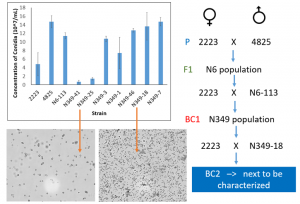 Conidiation is the process by which fungi asexually reproduce from spores. As these spores are dispersed to promote survival, pathogenic fungi can spread disease to humans and plants, so we study this mechanism in the non-pathogenic model system Neurospora crassa. There is a lot of variation in the number of conidia produced by a population of fungi, and we want to know what genetic elements are underlying that variation. A quantitative trait loci study has been performed that linked a region on chromosome 1 to this trait of producing abundant conidia. By performing genotypic and phenotypic analysis of populations, backcrossing, and examining the narrowed down quantitative trait loci region in each backcross population, we can discover candidate genes that may contribute to this trait.
Conidiation is the process by which fungi asexually reproduce from spores. As these spores are dispersed to promote survival, pathogenic fungi can spread disease to humans and plants, so we study this mechanism in the non-pathogenic model system Neurospora crassa. There is a lot of variation in the number of conidia produced by a population of fungi, and we want to know what genetic elements are underlying that variation. A quantitative trait loci study has been performed that linked a region on chromosome 1 to this trait of producing abundant conidia. By performing genotypic and phenotypic analysis of populations, backcrossing, and examining the narrowed down quantitative trait loci region in each backcross population, we can discover candidate genes that may contribute to this trait.